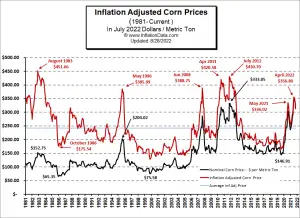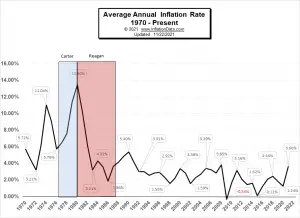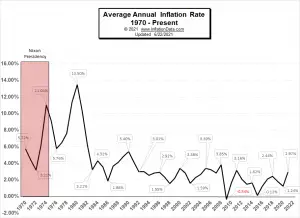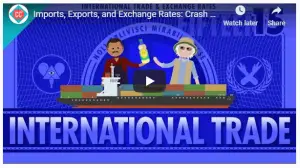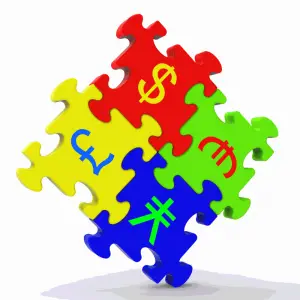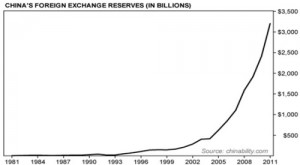Corn prices peaked in April and began coming down in May, June, and July... but all that may be over. According to Bloomberg corn prices may be set to drive up inflation. Recently they've been running a series of articles on Corn Prices: Their article US Crop Tour Stokes Fears of Looming Corn Shortage says, "Parched soils. Grasshopper infestations. Scorching heat. Hail damage. This year’s US corn crop has been put through the wringer... Things are so bad that scouts currently on a four-day tour through the Midwest are finding plants that are stunted and browning. Scores of fields have visible damage from pests. Cobs of grain are unusually small, and sometimes, stalks aren’t producing the … [Read more...]
How Nixon’s Revolutionary Move Influenced U.S. Inflation For 50 Years
Nixon is not remembered well by history because of the single defining moment of Watergate and the high inflation rate during his Presidency. However, according to a 2017 C-SPAN Presidential Historians Survey, Nixon actually ranked 10th among all presidents for his foreign policy. And the Siena College Research Institute, Presidential Expert Poll of 2010 ranked him 11th on foreign policy accomplishments. Of the 21 different categories, this survey ranked Nixon an average of 27.6th out of 44 presidents... so only slightly worse than average. Nixon’s China Visit One of Nixon’s foreign policy actions was to open diplomatic relations with China. This one action would have long-lasting … [Read more...]
How Does a Country “Export” its Inflation?
This question is interesting because most countries can’t just export their inflation because their currency is exclusive to their country. However, the U.S. is in the unique position of being the “reserve currency” of the world. In addition, several countries like Panama, Ecuador, and Zimbabwe, actually use the U.S. dollar as their currency and don’t even have their own currency at all. So the U.S. currency has a greater than normal influence on other country's economies. Exporting inflation is a Government's dream scenario. If they could print all the money they wanted and not suffer the consequences of their actions, it would be a dream come true for politicians. Printing money boosts … [Read more...]
Imports, Exports, and Exchange Rates
The world has a global economy. It’s no longer possible to survive as an isolationist. Macroeconomics will tell you that it is most efficient to have each country produce what it can produce cheapest so that all may prosper due to lower-cost goods and increased production. Not surprisingly, the U.S. is the world’s largest importer and also it is no surprise that we import a lot of stuff from China. According to the U.S. Census bureau, in 2018, we imported $539,675.6 Billion worth of goods from China while only exporting $120,148.1 Billion to China for a total trade of $659,823.7. So, in many ways Canada is actually a better trading partner than China since although we imported $318,824.2 … [Read more...]
Why Does China Want to Lower the Value of Its Currency?
The U.S. Labels China a Currency Manipulator On August 5th, 2019, the U.S. Department of the Treasury designated China as a 'currency manipulator'. China has been on the U.S.'s watch list for quite some time. The U.S. believes that China "engaged in persistent one-sided intervention in the foreign exchange market". So the U.S. is requesting that the International Monetary Fund (IMF) "eliminate the unfair competitive advantage created by China's actions". Why would China want to keep the value of its currency artificially low? How Currency Exchange Rates Affect Businesses Currencies are constantly changing in value against other currencies. This is based on a variety of factors … [Read more...]
U.S. Foreign Exchange and The Chinese Currency Exchange Rate
U.S. Foreign Exchange The number of international corporations and financial professionals that follow the ever-changing ratio of U.S. dollars to Chinese Yuan has increased and expanded beyond its borders. This is an indication of just how critical the trade relationship that binds the world's two largest economies has become. Although the relationship between the United States, Canada and Mexico continues to be even more robust than the Sino-American arrangement, the consumer economy of the United States is heavily dependent upon smooth flows of goods from the workshops of China to the Pacific ports of California and Washington State. In many ways, the continued harmonious economic … [Read more...]
Why (and How) China is Boosting the Price of Gold
The History of Gold Prices (and How We Got Here) To get the full picture of the current price of gold we have to look back nearly 100 years. In the 1800's and early 1900's gold played a key role in international monetary transactions. The gold standard was used to back currencies. Each country determined a fixed exchange rates for its currency, i.e. how many ounces of gold each unit of currency was worth. Trade imbalances (importing more than they exported or vice versa) could rectified via the exchange of gold reserves. A country with a deficit would have to ship gold to the country with an excess. Any country experiencing inflation would lose gold and therefore would have a decrease in … [Read more...]

